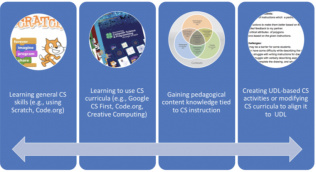
Planning K-8 Computer Science through the UDL Framework
This paper describes the rationale for using the UDL framework for designing K-8 CS instruction as well as preliminary findings from a National Science Foundation STEM+C study that examines instructional strategies that support students with disabilities and other struggling learners through Universal Design for Learning (UDL).
Due to the historic underrepresentation of women, people with disabilities, and people from a broad range of cultural and socioeconomic backgrounds in computer science (CS), there is growing demand to provide CS opportunities in K- 12 settings. As a result, school districts are beginning to implement CS For All initiatives. Consequently, there are increasing demands on teachers to find ways of making CS instruction accessible and engaging to a broad range of learners. Unfortunately, few resources exist to guide teachers in how to engage a broad range of learners in CS instruction. This paper describes the rationale for using the UDL framework for designing K-8 CS instruction as well as preliminary findings from a National Science Foundation STEM+C study that examines instructional strategies that support students with disabilities and other struggling learners through Universal Design for Learning (UDL). Secondly, this paper describes the collaborative efforts between the Creative Technology Research Lab (CTRL) and New York City’s K- 12 CS For All initiative in support of teachers in implementing universally designed CS instruction across grades K-8. Lastly, this paper provides resources developed through these initiatives. Implications for practice and future research directions will be shared.
Share this resource:
Posted date:
January 17, 2019
Access the full resource here if it does not render.
